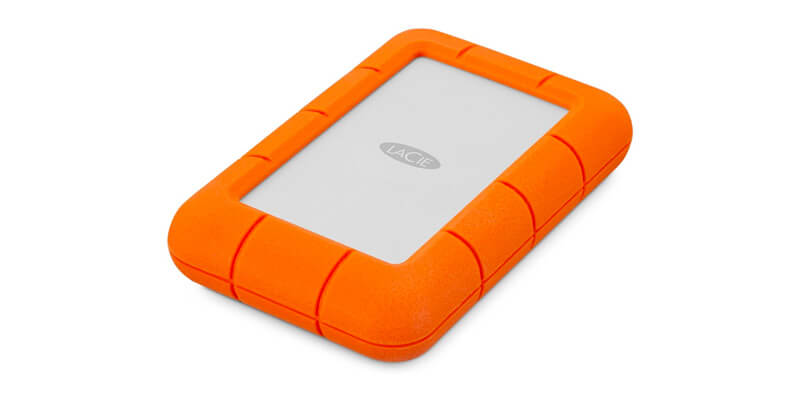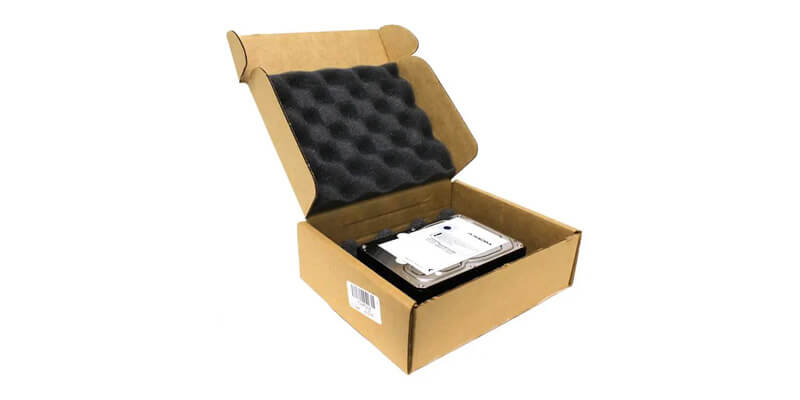If you work with heavy media files like raw camera footage or 4K video, there will come a point in your career where you have to send a hard drive.
I know, it sucks, but it’s one of the few ways to effectively move terabytes of data from point A to B (unless you use MASV). So, with that in mind, get your bubble wrap and packing tape ready for this guide on how to ship hard drives. 📦
I’ve compiled the input of several data recovery experts who have a fair amount of experience shipping and receiving hard drives and other physical storage.
In this how to ship hard drives guide, you’ll learn:
- When you should ship a hard drive
- How to pack a hard drive for shipping
- Tips on how to safely ship a hard drive
- How to send large files without shipping hard drives at all
Table of Contents
Should I Ship a Hard Drive?
To be clear, I don’t recommend shipping a hard drive.
It’s a time-consuming process, prone to delays, and susceptible to damage. The best way to deliver big files — up to 15 TB per file — is to use MASV, the fast, easy, and secure way to send large files anywhere in the world over the cloud (more on this later).
But, it’s a fact of life for filmmakers and video professionals that, sometimes, you have to deliver files physically, either by handing a hard drive to a local courier, or shipping a hard drive internationally.
Some situations where shipping hard drives are required:
- You are shooting in an area with poor/limited internet connectivity.
- Your file transfer solution can’t support files past a certain size.
- Your clients or partners prefer receiving a physical drive.
Whatever the reason, sometimes you may have to resort to shipping hard drives. So, let’s break down the steps on how to ship hard drives.
Fast Cloud Delivery of Large Files
Send up to 15 TB per file with MASV. Try today for free.
Step 1: Choosing a Hard Drive

Step one on how to ship hard drives: get an external drive…but which one? My colleague put together a guide on the 5 best external hard drives for video pros, so make sure to check that out!
- Solid-state drive (SSD). This is the preferred type of drive to use, especially when shipping hard drives internationally for long distances. Unlike a spinning hard drive, SSDs contain no moving or breakable parts, so they’re far more durable. The only catch is that they’re considerably more expensive than a traditional HDD.
- External hard disk drive (HDD). Although affordable, their many moving parts make them susceptible to damage during shipping. Most experts recommend a rugged hard drive because it can absorb more punishment.
- Internal HDD. While they’re not nearly as resilient as SSDs or rugged HDDs, you can ship internal hard drives with relative confidence if you use the proper packing methods (explained below).
This great Filmmaking Basics video tells of the data transfer process used by the crew of Aquaman, which involved shipping multiple copies of footage on multiple drives from Australia every day. That way, if most of the drives failed or were damaged en route, at least one drive would arrive intact.
While this process was ultimately successful (the movie was released in 2018) it’s not a very efficient method of transferring files internationally. It’s also crazy expensive. So unless you have the financial backing of Warner Bros, I don’t recommend sending multiple identical drives.
Stop Shipping Hard Drives
Send raw camera footage and 4K+ video with MASV.
Step 2: Preparing Files for Delivery
Step two is to prepare your files for delivery. This means loading up your hard drive with the correct folders and files. And trust me, it’s not as simple as dragging files from your computer onto a drive and calling it a day.
When you ship a hard drive, chances are, you are handing it off to somebody else to continue your work. You need to make sure your folder structure is organized, with proper file naming conventions and a hierarchy of subfolders and nested files.
This structure will determine your team’s proxy workflow and how they link proxy files with original media.
Step 3: Creating Backups
This probably goes without saying, but I’ll say it anyway: always keep a backup copy of any files shipped on a hard drive.
That’s because any physical storage can take damage en route — either from the blunt-force trauma of a hard impact or through electrostatic charges generated in the environment around your package.
A damaged hard drive can lead to data failure, which leaves your clients or partners unhappy. You can use data recovery services but that means delays, extra work, and added expense.
And if your hard drive were to go missing en route without a backup copy? Well, you’re basically screwed in that case.
🎯 Note: All MASV transfers are stored in our secure cloud storage, for free, for up to seven days. You can choose to keep files longer for an extra $0.10 per gigabyte. We also integrate with most major third-party cloud storage tools. You can automatically backup files to your preferred cloud storage via MASV.
Media File Transfer with MASV
Send large videos, raw photos, DCPs, and other high-resolution media assets
Step 4: Hard Drive Packaging

A specialized box for shipping hard drives by Emenac Packaging
How to pack a hard drive for shipping will depend on the type of drive you selected in Step 1, but you should always err on the side of caution when shipping hard drives.
However, hard drive packaging is especially important when shipping HDDs with breakable parts.
This video from StorageReview explains how to pack a typical 3.5-inch HDD:
- Wrap the drive in a hard drive anti-static bag
- Wrap a small amount of bubble wrap around the bag to space it out from the sides of a flat-style box, leaving a small gap between the front, back, and sides.
- Spray some foam insulation into the gaps between the front, back, and sides.
- Seal the box. After the foam dries in five to ten minutes, you’re good to go.
Including any necessary power and interface cables in your package is also advisable.
Other experts advise packing HDDs in a static bag and then wrapping it in at least three to six inches of bubble wrap. Most data recovery experts advise against using popcorn foam, paper flakes, or other packaging materials that could cause electrostatic discharge.
One of the best ways of shipping a hard drive without requiring a lot of extra packaging is to enclose the drive in a hard case or hard drive shipping container.
Digital cinema packages (DCPs) sent to cinemas and film festivals are typically delivered within CRU drive enclosures, which are extremely tough DX115 hard drive cases originally designed for military use.
💡 Read More: How SimpleDCP Simplified DCP Delivery With MASV
Fast, Reliable Large File Delivery
Deliver large files on time, every time.
Step 5: Shipping Method
Use a courier you can trust when sending valuable IP across the country (or the world). Some experts say they only use UPS or FedEx when shipping hard drives internationally, but DHL is another courier that gets mentioned fairly often.
Some other best practices when it’s time to choose a courier include:
- Choose strategically: Ensure your courier has a location relatively close to your package’s destination, so you’re not racking up unnecessary transportation costs.
- Go Early: Arrive at the shipping facility early so your shipment has a better chance of being picked up the day you drop it off. Also, send your drive well in advance so you’re not stuck paying rush delivery fees.
- Weigh it: To understand the costs of your hard drive shipping box in advance, you can weigh your package and use the courier’s online shipping calculator.
- Make it traceable: Whichever company you use, make sure you receive a tracking number for your package.
- Include signature release: Go for a shipping option that requires a signature before a recipient can take possession.
- Get it insured: Most reputable courier companies offer insurance. Get it.
- Know the rules: Avoid nasty surprises by familiarizing yourself with the destination country’s applicable customs duties and import regulations.
Step 6: Tracking Delivery
Lastly, once your hard drive shipping box is on a truck/plane, you’re not off the hook. You need to keep track of the package and act quickly if there’s a delay or issue at Customs. It happens more than you think, especially with electronic items.
Share Files With Your Remote Team
Send large files to clients and collaborators anywhere in the world.
An Alternative to Shipping Drives (Save Time and Money)
As a recap on how to ship hard drives:
- Choose a durable external drive to transport, ideally an SSD since it doesn’t have any internal moving parts.
- Package files with the correct naming conventions and folder structure so your recipient can work with proxies/original media.
- Always, always keep a backup of the files you plan to ship.
- Put your hard drive inside an anti-static bag and wrap in layers of bubble wrap; then place it into a hard drive shipping box (ideally with a hard exterior shell); and finish up by filling any gaps with foam.
- Determine your shipping provider and delivery time and method.
- Monitor your delivery and act on unforeseen delays or issues at the border.
Shipping hard drives isn’t the easiest method to share large files but I get it; sometimes, there’s no other choice.
But for every other occasion, you should consider using MASV, a hard drive alternative.
MASV is faster, safer, and way less annoying than shipping hard drives. It’s the swift, reliable way for filmmakers and video pros to transfer large media files anywhere in the world over the cloud.
With MASV you can:
- Send up to 15 TB per file for virtually unlimited file sizes
- Maintain folder structure so you can easily drag-and-drop files from your computer
- Keep track with a detailed log of your transfer history
- Store backups in the cloud as an extra failsafe
- Create and share an upload portal to collect files
- Accelerate transfers with Multiconnect internet bonding, automations, and 10Gbps optimization
Plus, there’s no barrier to entry. You don’t need a shipping label to get started. Start free today and see for yourself; you even get 10 GB free every month. After that, it’s Pay As You Go per transfer for flexibility, or opt for low-cost subscriptions for significant savings.
Try MASV for Free
MASV is free to use; you get 10 GB free every month.
MASV now works with your favourite apps
Integrations To Help You Streamline Your File Transfer Workflow.

Fast, Easy, and Secure Transfer of Large Files
Create a free MASV account to get started